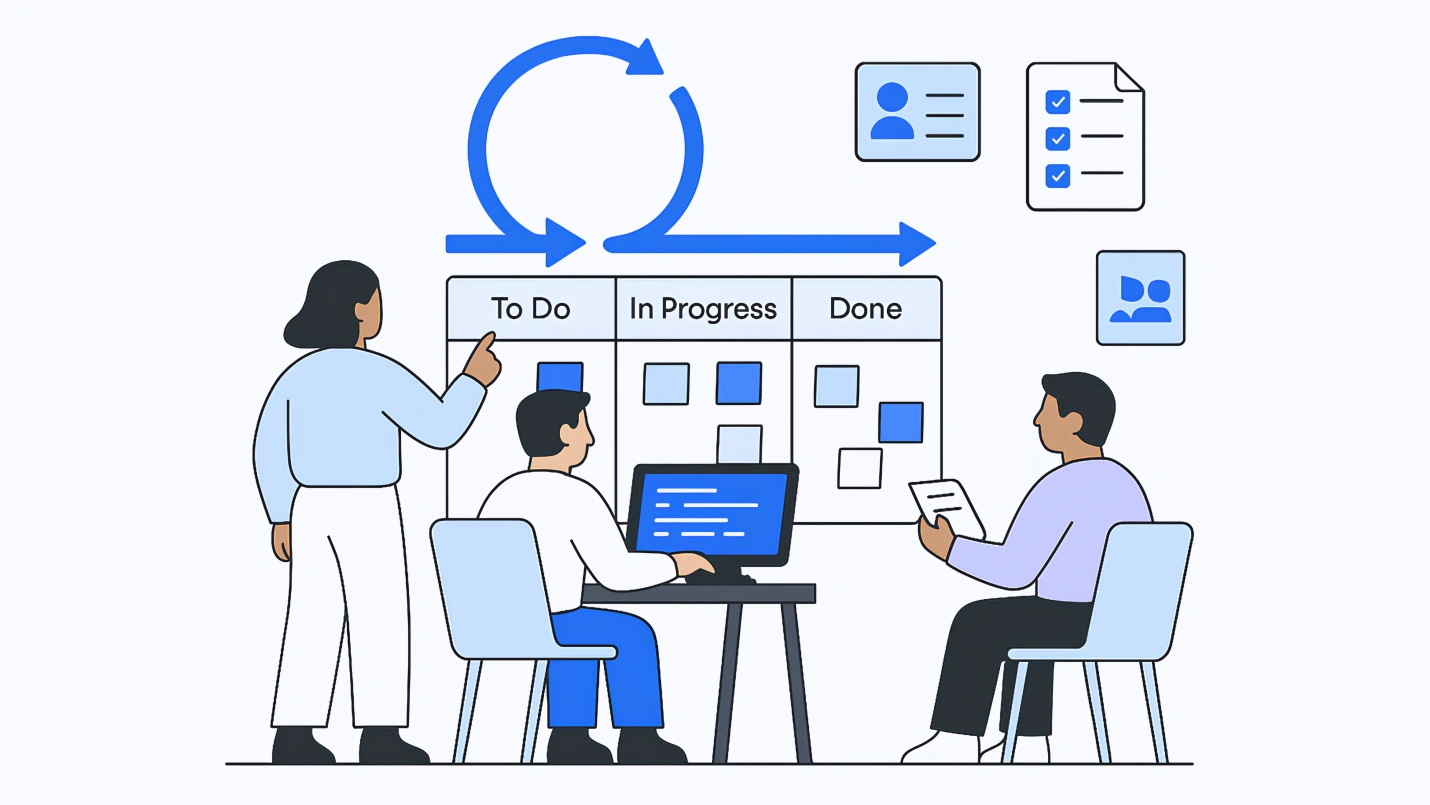Summary: Established companies constantly need help to become more dynamic with Agility. An organization can renew itself, adapt quickly, and thrive in a rapidly changing, uncertain, rough environment through agile software development. How? Let’s read.
With 2020 being a year of tumultuous change, negative economic pressures and growth opportunities knocked on our doors. COVID-19 intensified the pace of technological change, hyper-competition and increased customer expectations.
The need for remote work, coupled with demands by consumers for personalized, streamlined online experiences, pushed businesses to accelerate their digital transformation. McKinsey Research notes that the recovery from COVID-19 will be digital, with organizations transforming to “virtual, digital-centric, and agile.”
In 2025, we will enter a year of transformation and rapid innovation. Businesses need their software development processes to be concise, fast, and adaptable to customer needs to develop digital products at a pace that meets the demands of today’s consumers. Agile software development has re-emerged as a leading choice to meet the demands of 2025 and beyond.

Earlier, businesses relied on traditional waterfall software development, completing projects in sequential phases. In this approach, products aren’t vetted by customers until they are complete, often leading to failure. By contrast, Agile software development takes an incremental, iterative development process. With Agile, both the requirements and the solutions evolve through an ongoing process of feedback and collaboration well suited to a period of constant disruption.
68.6% of business leaders define Agile as a holistic approach that focuses on customers’ needs and is quick to respond to changes in the marketplace.
68.6% of business leaders define Agile as a holistic approach that focuses on customers’ needs and is quick to respond to changes in the marketplace.
Empirical Process Control
Empirical process control is a philosophy and the principles used in agile software development. It is based on the idea that the best way to manage a software development project is to focus on the frequent delivery of working software, the collaboration between team members, and responding to change. In addition to iterative and incremental development, empirical process control emphasizes the importance of collaboration between team members and stakeholders. Waterfall software development requires that everything be defined upfront. We can predict what we need to do and set up simple steps. In contrast, Agile development methodology is rooted in empirical process control, a more adaptive process.
Empirical process control is about adapting to the unexpected. The three pillars of empirical process control are
- Transparency — Knowing and sharing all the facts at every step
- Inspection — Being open to continuous improvement on the product, the team, and the software development process
- Adaptation — Adapting based on the feedback gathered during the inspection
While the waterfall methodology and empirical process control are very different, they can be used in certain situations. For example, some teams may use a hybrid approach to plan and predict certain aspects of the project using the waterfall methodology, then use empirical process control to deliver and refine the software iteratively. However, in most cases, teams will choose one approach or the other, depending on the specific needs and goals of the project. The purpose of Agile is to discover and develop an optimal solution iteratively. Agile provides an adaptable framework that results in faster time-to-market and measurable data points. Agile methodologies include Scrum, Kanban, Crystal, or Lean Software Development.

Flexible and Precise
The software development process is called “agile” for a reason, allowing for an incremental and iterative process incorporating internal and stakeholder feedback to ultimately arrive at a product that meets the client’s requirements.

Businesses that adopt Agile methodology approach this planning phase with clear processes and mathematical formulae to define and prioritize user stories to create their product backlog (product requirements in the form of user stories).
Agile lets teams divide the project into workable modules (done in Sprints in the Scrum model) that each adds a complete function to the previous release. These Sprints are clearly articulated goals reported daily and at the end of each release.

While daily scrum meetings quickly incorporate feedback to each Sprint goal, the end of the Sprint allows us to redefine the backlog further to ensure our overall objectives are met.
Adaptability through Creative Destruction
Creative destruction is the process by which the new destroys what came before. We can look at this at a product development level, where feedback reinvents the product backlog, but creative destruction is also happening at a business level. Digital transformation is about introducing agility into how a business operates and the value delivered to customers.
And it’s not just about using the Cloud or releasing an app — it’s about embracing creative destruction, rethinking old business models, and experimenting to meet the needs of today’s marketplace.
Agile software development promotes innovation, speed, and adaptability, allowing businesses to respond more fluidly to changing conditions. Creative destruction recognizes that every part of the business (including products) constantly evolves.
All aspects of the product development process should be aligned under a strategic vision to discover, define, design & build, and deliver the results through continuous improvement. We express this through a digital transformation flywheel:

Built for Success
Agile software development and Scrum help deliver frequently tested and reviewed increments, adjusting the overall product and how the team works. Agile has helped many organizations respond faster to change, resulting in a more relevant product delivered in a shorter production style.
Agile software development projects are twice as likely to be successful than those that follow the Waterfall approach; Agile projects also improve time-to-market by 18-20%.

Agile development services can be leveraged beyond just software development, with the same philosophy helping organizations with their digital transformation, blending in principles of cross-functional collaboration, engagement, and lean processes.
Less Risky
Agile software development has comprehensive checks and balances on the product backlog, processes, and the team to ensure you are building the right product in the most efficient way possible. These development practices articulate user stories to make up the product backlog, followed by iterative and incremental development that better distributes risk:

Agile software development is about more than just Sprints; it’s a philosophy that supports the collaboration of cross-functional teams, effective communication, and transparency.
Shorter Cycles Avoid the 90% Problem
When one large task is divided into smaller tasks, it becomes easier for the Agile teams to master the iterations and the smaller tasks. One of the core tenets of Scrum is getting the work done. Rather than creating an environment where teams are 90% done with several different tasks, Scrum focuses on finishing their backlog items within the Sprint.
This approach helps the team focus on polishing the smaller tasks rather than thinking of, the larger product. With this level of focus, teams can reduce time-to-market. And despite increasing planning and communication, continuous feedback helps avoid costly re-work or misalignment of the product. Agile products provide transparency over the project’s progress since each Sprint is well-defined toward the ultimate product release.
How can businesses embrace agile marketing?
Agile marketing is a method that focuses on flexibility and collaboration. To embrace agile marketing, businesses can start by forming small, cross-functional teams and giving them the autonomy to make decisions and take action quickly. These teams should be focused on delivering valuable marketing initiatives and results and should be able to adapt to changes in the market or business environment.
Businesses can take the following steps to embrace agile marketing:
1. Adopt a customer-centric mindset:
Agile marketing focuses on the customer and their needs. This means regularly collecting customer feedback and using it to inform decision-making and prioritize tasks.
2. Create cross-functional teams:
Agile marketing requires collaboration across departments and teams. This can be achieved by creating cross-functional teams with members from different business areas, such as marketing, product development, and customer service.
3. Set clear goals and priorities:
Agile marketing requires a clear understanding of the goals and priorities of the business. This can be achieved through regular check-ins and retrospectives, where teams can discuss their progress and adjust their priorities as needed.
4. Embrace experimentation and iteration:
Agile marketing emphasizes the importance of experimentation and iteration. This means regularly testing new ideas and approaches and then using the insights gained to improve future efforts.
5. Embrace flexibility and adaptability:
Agile marketing requires a willingness to be flexible and adaptable in response to changing market conditions and customer needs. This means being open to new ideas and approaches and pivoting quickly when necessary.
How to promote the agility of the people in your organization?
To introduce, promote and improve the agility of the people in your organization, you can take the following steps:
1. Provide training and support:
Provide training and support to help your employees develop the skills and knowledge they need to be agile. This might include training on agile methodologies, collaboration tools, and communication skills. Communicate the benefits of agility to employees, including faster time to market, higher quality products, improved customer satisfaction, and increased flexibility and adaptability.
2. Encourage collaboration and teamwork:
This can help build trust and understanding among team members, improving their ability to be agile. Implement agile processes and tools, such as agile project management, to help teams work more efficiently and effectively. This can include using agile methodologies such as Scrum and collaboration tools such as Trello or Jira.
3. Promote a culture of experimentation and learning:
Promote a culture of experimentation and learning by encouraging employees to try new things and learn from their experiences. This can help them develop the mindset and skills they need to be agile. Create a culture that supports and encourages agility by promoting collaboration, experimentation, and learning. This can be achieved through regular communication and feedback and by providing opportunities for employees to work together and learn from each other.
4. Support ongoing development:
Support ongoing development by providing opportunities for employees to learn and grow. This can include providing access to training and development resources and encouraging employees to seek new challenges and experiences. Celebrate successes and learn from failures by regularly reviewing and reflecting on the progress of agile initiatives. This can help teams identify what is working well and what can be improved and help foster a culture of continuous improvement.
5. Encourage adaptability and flexibility:
Be open to new ideas and approaches and willing to change course when necessary. This can help employees develop the ability to respond quickly to changing conditions and take advantage of new opportunities.
What are the Disadvantages of Agile?
While Agile can be a powerful philosophy, there are better approaches for some projects. Agile is best suited to projects that are complex and longer in duration, supporting the benefit of Sprints and feedback loops. However, many common mistakes in Agile software development can derail even the most well-suited projects.
Despite the many advantages of Agile software development, organizations should be aware of the potential disadvantages, including:
1. The Need to Define Clear Processes
A lack of clear processes often leads to teams becoming frustrated or sidetracked. Agile, as a philosophy, also requires that organizations evolve their processes and methodologies to suit the project. The evolution of Kanban, Spiral, Lean, or Extreme Programming (XP) offers flexibility to support Agile software development.
2. Time Consumption
When a project involves many dependencies, it can be more difficult to define Sprints or demonstrate work to date. The need for daily scrum meetings, reviews, and retrospectives adds time to the project.
3. Unpredictability
Agile methodology can result in many product design and backlog changes. While this can ultimately result in a product better aligned to support the business objective, teams must be adaptable to constant change. Some key functionalities can only be tested close to the end of the project, despite the impact such testing can have on the entire project.
Frequently Asked Questions
Agile, Scrum, Waterfall, and Kanban are all project management methodologies. Agile and Scrum are both iterative and incremental approaches to project management, while Waterfall is a linear, sequential approach. Kanban is a method for managing and improving workflows.
The agile Manifesto is a set of guiding principles for software development that values individuals and interactions over processes and tools, working solutions over comprehensive documentation, and customer collaboration over contract negotiation. It was first introduced in 2001 by a group of software developers looking for a better way to build software. Agile principles have since been adopted by many organizations and teams around the world to help them deliver high-quality software quickly and efficiently.
There is no formula for agility, as it is not a precise science or calculation. Instead, agility is a mindset or approach that emphasizes flexibility, adaptability, and rapid response to change. Agile organizations and teams focus on continuously improving their processes and practices and on being responsive to the needs of their customers and stakeholders.
- Individuals and interactions over processes and tools: Agile teams value people and how they work together over rigid methods and tools.
- Working solutions over comprehensive documentation: Agile teams prioritize delivering working software over comprehensive documentation.
- Customer collaboration over contract negotiation: Agile teams focus on collaboration and communication with customers to ensure they deliver the right solutions.
- Responding to change over following a plan: Agile teams are flexible and adaptable and can quickly react to changes and new information.





